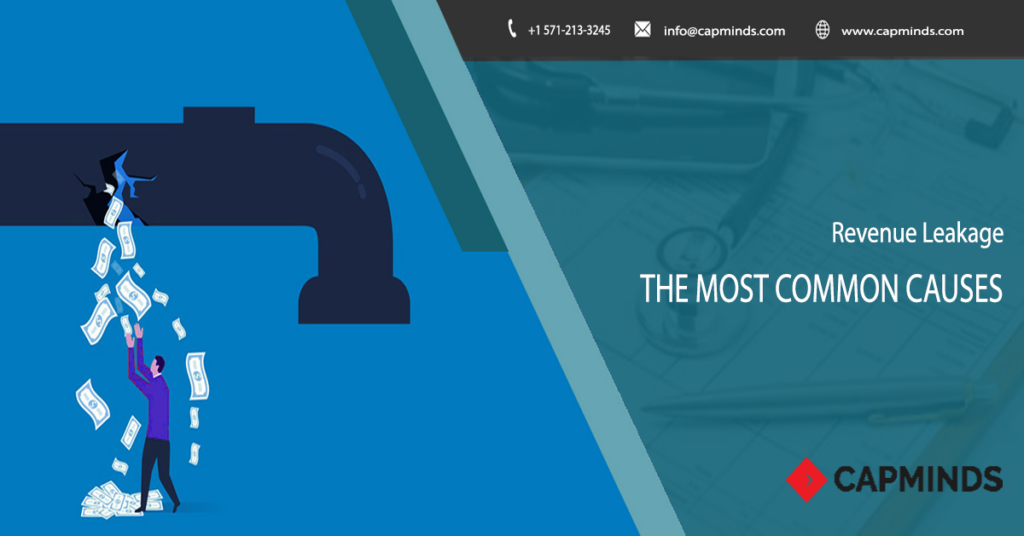Are you facing revenue leakage in your clinic?
Managing Revenue Cycle Management (RCM) is very difficult and complex. There are literally hundreds of ways to lose reimbursement here a little loss and there a little loss, all adding up to the point where almost all practices are continually financially squeezed. Reimbursement rates have dropped for years, while all other expenses–rent, personnel costs, medical supplies–continue to rise. So a medical group’s only way to maintain its net profits is to control costs and reduce missed reimbursements. For medical practices, here are the top 9 sources of lost revenue and expense drain (leakage), in order:
Medical Billing or Revenue cycle management (RCM) is a very complex and detailed one. There are literally many ways to lose reimbursement, small-small losses, all adding up will leads to heavy financial pressure on hospital or clinic, all the time. Reimbursement rates have also been reduced for years, while the rest of other costs like rent, staffing costs, medical supplies – keep increasing. So to improve financial health is to control costs and minimize lost reimbursements.
Here are the top important sources of revenue leakage for medical practices
1. Insurance Contracts: Reimbursement rates are not good enough, but if you don’t track underpayments properly ontime, you can’t respond to this source of revenue leakage.
Solution: Make sure your medical billing staff is identifying and responding to all short payments, filing appeal claims with payers , then & there. As a safety net to those efforts, a month-end report should identify short payments that were missed. It is especially important to catch short payments with your higher-volume CPT codes. That can add up to a lot of “revenue found”.
2. Non-Billed Claims: It’s easy to lose a charge if no reconciliation process is in place to match patient encounters to submitted claims. And those missed charges can add up to a high percentage of a practice’s net profit.
Solution: Make sure your appointment schedule is kept up-to-date by your staff with appointment changes, cancelations and no-shows. Then you can run an “unbilled charges report” from your practice management (PM) system to located missed charges and bill for those claims. If your PM system can’t run an “unbilled charges report” then consider having that report programmed for you. More revenue found if you do.
3. Fee Schedule Problems: Setting a proper fee schedule (price) for each and every procedure you provide can be daunting. Setting your fees too low will result in lost revenue. Setting your fees too high can be negatively perceived by patients. Setting fees not consistent with any benchmark will make it hard to keep overall tracking of your fee structure in a way that makes sense.
Solution: Set your fee schedule as a percentage of the current year’s Medicare rates, usually between 2 and 3 times the Medicare allowable for each procedural code for primary care physicians and a higher multiple for specialists. Make sure you run monthly reports that will highlight if your fees are being paid at 100% of your gross charge by any payer. If so, your fee schedule is likely too low, at least for that payer.
4. Credentialing Issues: Provider changes in a practice can create denied claims with long lead times to fix. And it can be a nightmare to manage provider enrollment across multiple payers, all with different forms to fill out and rules to follow. Once all providers are properly credentialed, you aren’t done, because time flies and it is easy to miss annual re-credentialing deadlines. When that happens, you find out you have a problem when claims start denying and then it’s often too late.
Solution: Outsource credentialing management to a credentialing professional that has all the forms, knows all the payer rules and has software that can track your re-credentialing dates. Like any outsourcing decision, you need to pick the right company to manage your credentialing for you, but otherwise the value proposition for doing so is substantial.
5. Poor Patient Balance Management: Long gone are the days when a provider can make ends meet by “taking only what insurance pays” on submitted medical claims. Patient balances make up an increasing percentage of total claim reimbursements for all providers. And the trend toward high-deductible benefit plans continues. So every medical practice needs to manage and collect patient balances due as an important component of overall revenues.
Solution: Implement an effective patient statement and delinquency letter protocol, with effectively designed workflows, moving to electronic statement/texting and incorporating patient payment portal and credit card payment functionality. It is very important to also provide for a high level of customer service – taking patient phone calls to answer billing questions – and providing for payment plans for patients struggling with medical bills. Outbound calls to patients who don’t respond to patient statements and delinquency letters can cost-effectively bring in additional reimbursements. And finally, a professional collection agency should be engaged to work unpaid patient balances that are not otherwise converted.
6. Deficient Software Systems: No software is perfect but bad software can cost you money in many different ways. Clinical (EHR) system issues are usually more apparent to providers because they are using that software continuously. But practice management (billing system) software issues can be harder to diagnose. Sometimes the problem is hardware or network related. If your systems are running slow or if it seems like it takes too much labor to get the work done, then your software might be contributing to the problem.
Solution: Get your computer hardware and network checked out and upgrade old equipment if necessary. Confirm that your internet bandwidth is sufficient, especially if your software systems are hosted. If you aren’t upgraded to the most current version of your existing software, you might be missing some important functionality. And if your software systems are old and outdated, consider making the investment in a new system. At least have a review made and the return on investment analyzed. Old, slow, legacy software and hardware never makes any sense in supporting a dynamic practice.
7. Poor Claim Denial Management: Everyone knows it’s hard, labor-intensive work pursuing denied claims, and therefore costly. So very often the work just doesn’t get done, or done well. And that’s more costly. Most claim denials at the clearinghouse level are worked in most billing settings. Most initial EOB denials (zeroes) are also worked in most billing settings. But claims for which there is no payment or denial by payers, and appeals filed on denied claims without a timely payer response – these claims often result in write-offs and significantly affect a practice’s cash flow.
Solution: Dedicate specific staff resources to denial management and develop detailed protocols for managing this aspect of the revenue cycle. And then measure performance of the staff devoted to this key metric. Also consider that this is where outsourcing can greatly assist in cost-effectively capturing lost revenues. Start by reviewing the scope of the problem in your medical group and then take action.
9. Front Desk Staff Issues: Problems at the front end of any sequential process can create havoc downstream. And your front desk staff is at the front end of your revenue cycle. They take patient appointments, they enter patient demographics and most importantly, they enter and update patient insurance information into your PM system. Very often the correct insurance payer is identified but the wrong insurance plan for that payer is attached to a patient account. Or patient insurance in the system is not updated correctly because it takes some discipline at the front desk to continually check patients’ insurance for changes. All of these issues can result in claim denials and lost revenues.
Solution: Review and update your front desk policies and procedures with downstream revenue cycle implications strongly considered. Simple straight-forward fixes up front can greatly impact your bottom line. Once improved, front desk performance should be monitored empirically by RCM dashboard reporting. Denials (unpaid claims) that are caused by front desk errors and omissions should be consistently tracked to make sure that this aspect of revenue cycle leakage is permanently fixed.
10. Deficient Reporting: Many systems that track payer denials have no way to track claims that are neither paid nor denied. A claim goes out, the days go by and nothing comes back. These claims are essentially lost until they appear on an Aging Report 60 or 90 days from the date of service. Most denial management systems don’t adequately catch this category of lost revenue. These claims are often first identified when they are untimely, giving payers the opportunity to deny ever paying them. Any significant number of claims in this category can be devastating to a practice’s revenue stream.
Solution: See what reporting can be produced from your software system. Usually a monthly reporting “package” produced at month end is ideal so long as all the requisite content in included. A revenue cycle management consultant can provide the expertise to know what information you need to have and how to structure your reporting to be most useful. And if your software system can’t produce what you need, it is often possible to program a customized set of reports or a program a monthly “data extract” from your software database, dropping that data into a dashboard system for your use.
11. Billing Staff Issues: It doesn’t matter how good your PM software may be if your staff (or your billing company) can’t use that software effectively to get results. Poor RCM execution will defeat good software systems every time. And a mediocre (average) billing staff performance could lose you thousands of dollars each month compared to the excellent staff performance your medical group deserves. Revenue leakage occurs in multiple places, a little bit here and a little bit there. Revenue cycle management is difficult and complex, so it is easy to be defeated by the magnitude and multitude of best practice RCM processes. Often times the losses are not intentional. A staff can work hard and be committed to its work but still come up short because of ineffective protocols, inefficient workflow and poor process execution.
Solution: Make a commitment to evaluate the processes, the software, the protocols and the staffing resources committed to your practice’s revenue cycle. Determine whether or not your RCM staff is maximizing your reimbursements, net of costs and within compliance guidelines. If you identify staff that is not being effective with any particular part of the revenue cycle process, immediately commit to resolving the issue. Your medical group can’t afford not to engage the very best staffing resources possible to manage your revenue cycle. Your financial health depends upon a regular, optimized cash flow, without undue reimbursement loss.

 Author: Pandi Paramasivan
Author: Pandi Paramasivan


